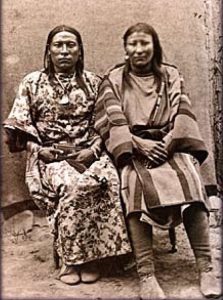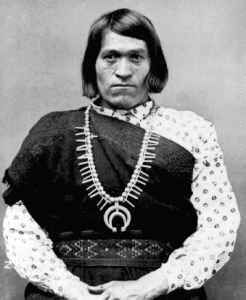Trans-America Part 5: The Berdaches
Perhaps best illustrating the spiritual aspect of transgenderism were the Native American transgenderists known as Berdaches.
The Berdache were men, or women, who chose to combine gender roles, often dressing as the opposite sex. They were respected spiritual leaders and healers thought to possess supernatural powers, and were revered for their ambi-gender status. Berdaches had the unique permission by tribal society to adopt the social roles of women, men, or both, by their own choice. Their greatest contribution to their culture, however, came from utilizing their special cross-gender insights to mediate disputes between men and women of the tribe.
We’wha, a male-to-female berdache, known by anthropologists as the man-woman of the Zuni tribe, central New Mexico, was born in 1849. The tallest, strongest, and most intelligent of his tribe, he was an accomplished craftsman, specializing in weaving and pottery — considered male and female occupations respectively in Zuni Culture. He apparently engaged in farming, too – another male role, but also helped manage his family’s household, traditionally a woman’s role. We’wha, then, did not so much cross genders as he/she combined them.
In the matters of tribal religion and social conditioning, We’wha had been initiated into a male kiva society and fulfilled such male religious roles as reciting prayers on ceremonial occasions and making prayer sticks. He was also knowledgeable, however, in the religious lore of women, such as that which surrounded the rites and observances of pottery making.
As an adolescent, like all boys of the tribe, We’wha had received the first male initiation. Being a male-to-female Berdache, however, he was forbidden to take part in the second initiation.
Gender Viewed as An Acquired Trait
Zunis saw gender as an acquired trait, with children being considered essentially undifferentiated at birth but becoming increasingly specialized as they reached adulthood. As Berdaches were seen as having elements of both, they were, in a sense, a third gender.
The first religious symbol given to a Zuni child was an ear of corn. Male infants were given a single ear of corn; females a double ear, in which two ears had grown together. The raw material of both was the same, however — a seed of corn. Like any seed, biological sex represents only a potential.
In 1886 We’wha traveled to Washington D.C. in the company of anthropologists James and Matilda Stevenson who had befriended We’wha and had spent several years studying the Berdache tradition. He took the town by storm, befriending Speaker of the House, John Carlisle, and shaking hands with President Grover Cleveland.
When We’wha died, in 1895, she was attired in a woman’s ceremonial dress over men’s breeches.
This brings us to the end of our present study, but it is not the end of the story. Just as there were many cases before the period covered here, so have there been many more from the Reconstruction to the present day, and will continue to be as the human species evolves and sex roles continue to alter and mature beyond the dualistic paradigm of gender separatism.
 During this century we have begun to witness a redefining and expansion of sex roles within this country and around the world. Beginning with the entry of millions of women into the work force during the Second World War, the trend continued with the women’s lib movement that began in the 1960s and the men’s sensitivity movement that originated in the 1970s and ’80s.
During this century we have begun to witness a redefining and expansion of sex roles within this country and around the world. Beginning with the entry of millions of women into the work force during the Second World War, the trend continued with the women’s lib movement that began in the 1960s and the men’s sensitivity movement that originated in the 1970s and ’80s.
Because of Western Civilization’s historic prejudice and intolerance of anything outside the norm, transgendered people have been more feared than valued. Aside from a courageous few, such as those mentioned here, nearly all have remained in seclusion to avoid persecution. Today, however, through the work of the International Foundation for Gender Education, the International Conference on Transgender Law and Employment Policy, and numerous regional groups, there is an increasing public awareness that many of the world’s greatest citizens and contributors to its culture are a part of the transgendered community.
Transgenderism is still far from an easy path. But though often regarded as a choice of loneliness, for those who feel guided to this lifestyle, it is a path of freedom. Perhaps, in time, anatomical sex will no longer be the determinant of acceptable dress and behavior, and it will no longer matter what we choose to wear, nor how we wish to behave, as long as we do no harm to others; when we will no longer have to think in terms of crossdressing or of appropriate gender presentation, but of just being who we are.
Category: Transgender History





